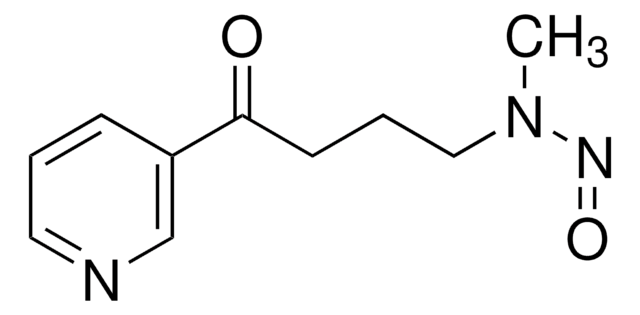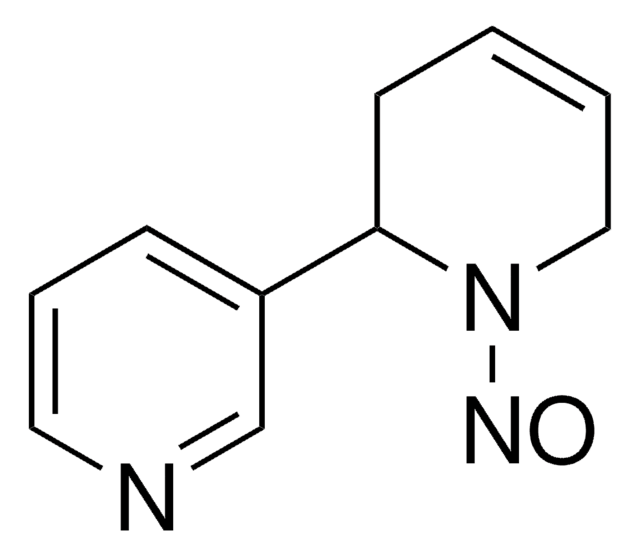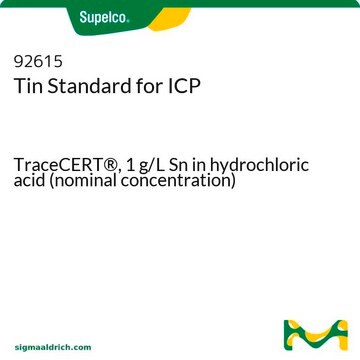59773
4-(Methylnitrosamino)-1-(3-pyridyl)-1-butanol
analytical standard
Synonym(s):
NNAL
Sign Into View Organizational & Contract Pricing
All Photos(1)
About This Item
Empirical Formula (Hill Notation):
C10H15N3O2
CAS Number:
Molecular Weight:
209.25
MDL number:
UNSPSC Code:
41116107
PubChem Substance ID:
NACRES:
NA.24
Recommended Products
grade
analytical standard
Quality Level
Assay
≥92.0% (TLC)
shelf life
limited shelf life, expiry date on the label
technique(s)
HPLC: suitable
gas chromatography (GC): suitable
solid phase extraction (SPE): suitable
application(s)
cleaning products
cosmetics
food and beverages
personal care
format
neat
storage temp.
2-8°C
SMILES string
CN(N=O)CCCC(O)C1=CN=CC=C1
InChI
1S/C10H15N3O2/c1-13(12-15)7-3-5-10(14)9-4-2-6-11-8-9/h2,4,6,8,10,14H,3,5,7H2,1H3
InChI key
OGRXKBUCZFFSTL-UHFFFAOYSA-N
General description
4-(Methylnitrosamino)-1-(3-pyridyl)-1-butanol is one of the major metabolite of nitrosamine 4-(methylnitrosamino)-1-(3-pyridyl)-1-butanone, which is a carcinogen responsible in inducing lung cancer in smokers.
Standard for Supelco MIP SPE cartridges. For more information request Supelco Literature T407075, T706031
Application
Refer to the product′s Certificate of Analysis for more information on a suitable instrument technique. Contact Technical Service for further support.
Storage Class Code
11 - Combustible Solids
WGK
WGK 3
Flash Point(F)
Not applicable
Flash Point(C)
Not applicable
Personal Protective Equipment
dust mask type N95 (US), Eyeshields, Gloves
Choose from one of the most recent versions:
Already Own This Product?
Find documentation for the products that you have recently purchased in the Document Library.
Customers Also Viewed
Sung Hoon Jeong et al.
Scientific reports, 11(1), 4536-4536 (2021-02-27)
Children are at risk of exposure to secondhand smoke. We aimed to evaluate the extent of their exposure to it in relation to their parents' smoking status by using biomarkers relevant to smoking. We evaluated 847 school-age children (6-12 years) who
Steven G Carmella et al.
Chemical research in toxicology, 15(4), 545-550 (2002-04-16)
4-(Methylnitrosamino)-1-(3-pyridyl)-1-butanone (NNK) is a tobacco-specific lung carcinogen which may play an important role as a cause of lung cancer in smokers. NNK is extensively metabolized to 4-(methylnitrosamino)-1-(3-pyridyl)-1-butanol (NNAL), which like NNK is a potent pulmonary carcinogen. NNAL in turn is
Yi Wang et al.
Cancer prevention research (Philadelphia, Pa.), 13(5), 483-492 (2020-02-28)
Tobacco smoking is the primary risk factor for lung cancer, driven by the addictive nature of nicotine and the indisputable carcinogenicity of 4-(methylnitrosamino)-1-(3-pyridyl)-1-butanone (NNK) as well as other compounds. The integration of lung cancer chemoprevention with smoking cessation is one
E M Leslie et al.
The Journal of biological chemistry, 276(30), 27846-27854 (2001-05-29)
Nitrosamine 4-(methylnitrosamino)-1-(3-pyridyl)-1-butanone (NNK) and its metabolite 4-(methylnitrosamino)-1-(3-pyridyl)-1-butanol (NNAL) play a crucial role in the induction of lung cancer, and NNAL-O-glucuronide formation and elimination are important steps in detoxification of these compounds. In the present study, we investigated the ATP-binding cassette
S S Hecht et al.
Cancer epidemiology, biomarkers & prevention : a publication of the American Association for Cancer Research, cosponsored by the American Society of Preventive Oncology, 4(8), 877-884 (1995-12-01)
Epidemiological studies indicate that vegetable consumption protects against lung cancer in humans, but the protective constituents have not been identified. Phenethyl isothiocyanate (PEITC), which is release upon chewing of watercress (nasturtium officinale), is a chemopreventive agent against lung cancer induced
Our team of scientists has experience in all areas of research including Life Science, Material Science, Chemical Synthesis, Chromatography, Analytical and many others.
Contact Technical Service










